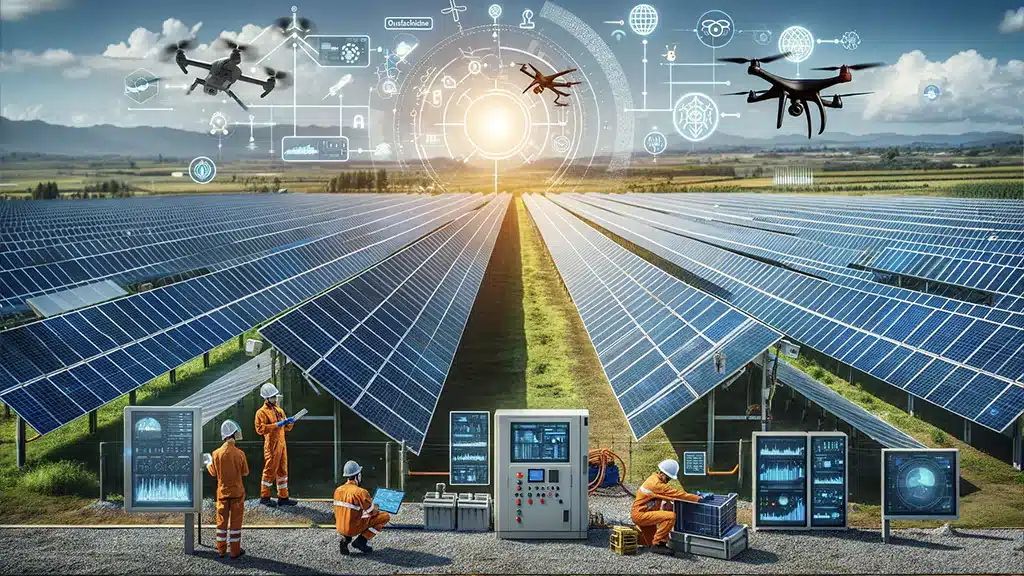 One of the biggest challenges associated with photovoltaics is ensuring reliable and efficient solar power maintenance, which occupy large areas and consist of many components. To maintain high efficiency and performance of solar panels, regular monitoring, PV panel maintenance, and repair of installations are necessary.
One of the biggest challenges associated with photovoltaics is ensuring reliable and efficient solar power maintenance, which occupy large areas and consist of many components. To maintain high efficiency and performance of solar panels, regular monitoring, PV panel maintenance, and repair of installations are necessary.
For this purpose, increasingly advanced technologies are being used, allowing for quick and accurate diagnosis of the technical condition of the solar farm, as well as automation and optimization of servicing processes. In this article, we will present several examples of new technologies that are being used or will be used in the near future in the solar power maintenance.
New technologies in solar power maintenance: Drones and artificial intelligence
Drones are unmanned aerial vehicles that can be remotely controlled or operate autonomously. Drones are increasingly being used in various sectors of the economy, including renewable energy. In the servicing of photovoltaic farms, drones can serve many functions, such as:
- Visual inspection of PV panels, which allows for the detection of damage, dirt, shading, or other anomalies that may affect the performance of the installation. Drones can perform inspections faster and more accurately than humans and can reach hard-to-access areas.
- Thermography, which involves measuring the temperature of PV panels using a thermal camera. Thermography allows for the identification of hot spots, which may indicate damage or degradation of photovoltaic cells. Thermography can also be used to assess the quality of electrical connections and inverters.
- Photogrammetry, a measurement technique involving the creation of three-dimensional models of objects based on photos taken from different angles. Photogrammetry can be used to create maps and plans of photovoltaic farms, as well as to measure the surface area and tilt angle of PV panels.
Discover our service: solar power maintenance
Drones can also be equipped with artificial intelligence, which allows for the analysis and processing of data collected by drones. Artificial intelligence can be used to:
- Classify and locate damage to PV panels based on visual and thermographic images. Artificial intelligence can use machine learning and deep learning techniques to learn to recognize different types of damage and their locations on PV panels.
- Generate service reports and recommendations based on data collected by drones. Artificial intelligence can summarize inspection results, indicate priorities and repair costs, and suggest optimal solutions and service schedules.
Read also: SCADA: The Heart of Modern Solar and Wind Farm Monitoring (electrum.pl)
Robots and the Internet of Things
Robots are machines capable of performing physical tasks autonomously or under remote control. Robots are also increasingly being used in the servicing of photovoltaic farms, where they can serve many functions, such as:
 Cleaning PV panels, which involves removing dust, sand, snow, leaves, or other contaminants that may reduce the efficiency and lifespan of PV panels. Robots can perform cleaning regularly and automatically, and can also adapt to weather and terrain conditions.
Cleaning PV panels, which involves removing dust, sand, snow, leaves, or other contaminants that may reduce the efficiency and lifespan of PV panels. Robots can perform cleaning regularly and automatically, and can also adapt to weather and terrain conditions. - Repairing PV panels, which involves replacing or repairing damaged photovoltaic cells, modules, cables, or other installation components. Robots can perform repairs quickly and precisely, and can also minimize the risk of damaging other parts of the installation.
- Installing PV panels, which involves installing new PV panels or expanding an existing photovoltaic farm. Robots can perform installation efficiently and safely, and can also ensure proper connection and alignment of PV panels.
Robots can also be connected to the Internet of Things, which is a network of devices and sensors capable of communication and data exchange. The Internet of Things can be used to:
- Monitor the operation and condition of PV panels, inverters, batteries, and other photovoltaic farm components. The Internet of Things can collect and transmit data on voltage, current, power, temperature, humidity, sunlight, and other operating parameters and environmental conditions of the installation.
- Control and optimize the operation of the photovoltaic farm. The Internet of Things can regulate and adjust the operation of PV panels, inverters, batteries, and other photovoltaic farm components to ensure maximum performance and reliability of the installation. The Internet of Things can also collaborate with the power grid and other energy sources to ensure the stability and flexibility of the energy system.
New technologies in solar power maintenance – Summary
New technologies in solar power maintenance are not only an interesting topic but also a necessity in the face of growing demand for renewable energy. Drones, artificial intelligence, robots, and the Internet of Things are just some examples of technologies that are being used or will be used in the near future in the servicing of photovoltaic farms. These technologies aim to improve the quality, efficiency, and reliability of photovoltaic farm servicing, thereby increasing the economic and environmental benefits of photovoltaics.

